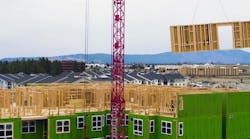Latest from News
For savvy electrical contractors with an eye on working smarter on job sites, using prefabricated electrical products or systems they build in their own shops or purchase from electrical manufacturers is nothing new.
But at this year’s NECA Show in Las Vegas, it seems like more exhibitors than ever were promoting prefabricated products. Whether the products were somewhat simple, like ground wires pre-installed in metal boxes, fixture whips, or boxes with screws already backed out, the electrical manufacturers seemed to have the same goal in mind — help electrical contractors work faster, safer, and more profitably on job sites.
At least one electrical manufacturer thinks using prefabricated electrical products and adopting some LEAN concepts of project management won’t be optional in the future, because new competitors in the construction market can produce modular buildings much faster than contractors employing traditional building methods.
In his NECA seminar, “Embracing Lean and Improving Profitability with Prefab,” ABB’s eFab Group Director Colin Ross said that many electrical contractors still rely on inefficient installation and project management methods developed decades ago. As a former general contractor, he was already familiar with many of the pain points contractors experience on job sites, including coordination of deliveries with suppliers, wasting time hauling product packaging from jobs and other inefficient tasks. ABB hired him to build a prefab operation that would solve many of these issues. His team works closely with electrical contractors, distributors and others in the supply and construction process to eliminate inefficiencies. One solution they developed for an electrical contractor working on Apple’s new headquarters in Cupertino, CA, a few years back was to prefabricate the cable tray being installed and to eliminate much of the packaging by shrink-wrapping the tray to pallets.
Ross urged electrical contractors to study the new competitors in the construction market that offer modular building solutions, including pre-built walls with core mechanical, electrical & plumbing (MEP) already installed. One example he gave is Menlo Park, CA-based Katerra. The company is currently building thousands of multi-family housing units in the United States using modular construction techniques and construction components pre-manufactured at its factories.
A case study on the Katerra website offers details on how the company was able to construct a basic multi-unit apartment building in Las Vegas in less than 90 days, when it would take more than 140 days to build a similar structure using traditional construction processes.
Katerra’s factories are heavily automated, and it uses robots and other automated equipment to cut and shape marble counter tops, produce wall panels and eliminate other labor-intensive tasks. Ross says the company even owns its own forest to harvest the lumber it needs for projects, and a quarry for some of the stone products it uses.
He notes that contractors can learn from how these new companies have streamlined the construction process. “There’s a betterway to be doing this,” he adds.













